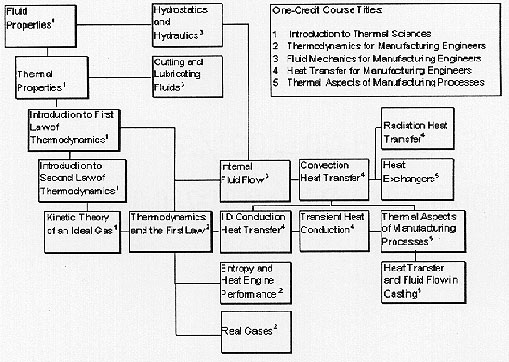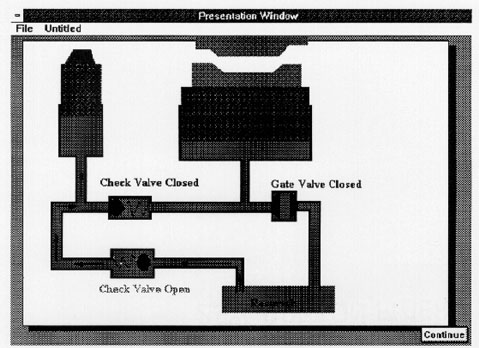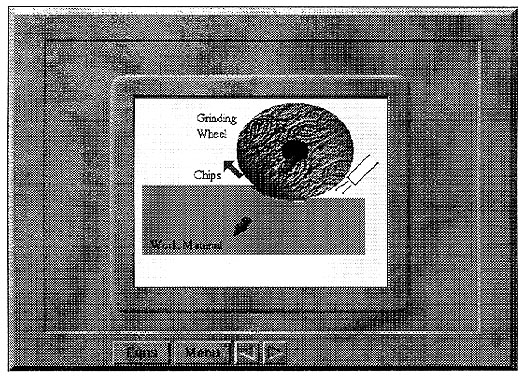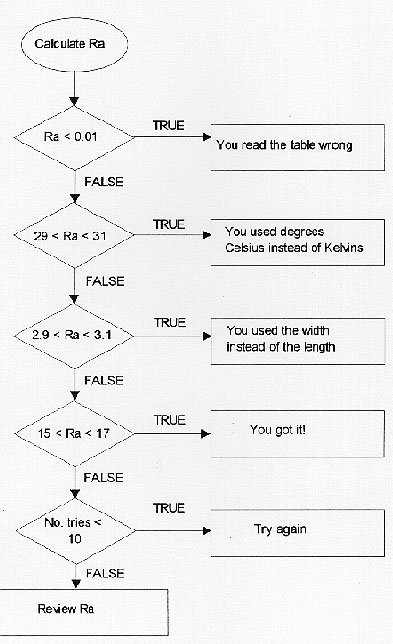
THERMOPHYSICS KNOWLEDGE AREA
FOR THE GREENFIELD
COALITION FOR NEW MANUFACTURING
ENGINEERING EDUCATION
This paper describes the approach, implementation, and lessons learned for a set of instructional modules that introduce candidates to the principles of thermal/fluid sciences, with applications to manufacturing engineering. Thermal/fluid sciences (thermodynamics, fluid mechanics, and heat transfer) are typically considered among the most difficult of topics taught in an engineering curriculum. This project attempts to make the subject matter more accessible to candidates by embedding the material within the context of manufacturing activities that are part of the candidates' daily experience. The foundational principles for most of the eighteen modules are taught in interactive tutorials written with the multimedia authoring package Authorware ®. The modules employ colorful illustrations, animations, video, and sound to bring life to the material. Candidates are asked to respond frequently to questions and take quizzes to promote active learning and provide immediate feedback. Complementing the computer-based tutorials are instructor-assisted problem-solving sessions, experiments, work-related team projects, case studies, or traditional lectures. The tutorials include periodic assignments such as computer problems (solved using a spreadsheet or mathematics package) and traditional "pencil-and-paper" problems.
INTRODUCTION
The NSF-sponsored Greenfield coalition offers an excellent opportunity to explore nontraditional methods for presenting thermophysics. (The traditional method is taken here to be the lecture). The instructional material is presented at the Center for Advanced Technologies (CAT), a manufacturing facility in Detroit employing a large minority population, and the center for an Associate's and Bachelor's level Manufacturing Engineering degree program. Students in the program (called "candidates" at the facility) are all full-time machinists. They receive onsite instruction after their work shifts in the form of lectures, computer-based tutorials, and hands-on laboratory experiences.
The mission of the Greenfield Coalition for New Manufacturing Education is to [ l ]
establish a new paradigm in manufacturing engineering/technology education that integrates actual manufacturing experiences into the academic programs.
With this in mind, our task as developers of the thermophysics knowledge area is to see that candidates receive instruction within the context of manufacturing. Thermal-fluid phenomena are ubiquitous in manufacturing activities. Examples include the delivery of cutting fluids to workpiece/tool interfaces, the heat flow and related temperature profiles in cutting operations, the solidification of castings, the fluid jet cooling of steel strips emerging from rolling mills, quenching, furnace drying and surface-treatment operations, manufacture of polymer filaments, welding, plasma spray coating, laser shaping, and thermal treatment of semiconductors. The importance of understanding thermal phenomena is crucial to the control of parameters such as surface finish, residual stress, fatigue strength, hardness, and part tolerances. At the CAT, there is also a host of other non-manufacturing-related phenomena, such as operation of the climate control system, performance of a cogeneration facility for electricity and steam, and characteristics of the building water supply system.
The thermophysics courseware development is one of the three stems constituting the Engineering Physics knowledge area for the Greenfield Coalition. The other two stems are Mechanophysics and Electrophysics. Initial delivery of the thermophysics material is slated for January of 1997.
APPROACH
The thermophysics delivery consists of eighteen modules described in detail in [2] and [3]. Figure I shows the flowchart for the sequence. The sequence is worth five academic credits, and the modules are grouped into one-credit course offerings as noted on the figure. The entire sequence is taken by candidates seeking both the Engineering and Engineering Technology Bachelor's degrees. The first five modules cover material normally offered in a second-year college physics class, while the remaining modules reach into the junior- and senior-level thermodynamics, fluid mechanics, and heat transfer courses normally taught in a mechanical engineering program. The five-credit thermal science offering cannot hope to cover the same amount of material, but our goal is to provide the manufacturing engineering student with the tools necessary to analyze thermal phenomena in his discipline.
Our objective is two-fold: to teach the theory and techniques necessary for a secure working knowledge of thermal phenomena, and to deliver the material in an effective way to this nontraditional student body. The breadth of material covered is normally taught in a sequence of three or four courses in a mechanical engineering program, and must therefore be carefully condensed for the candidates. This is mostly done using an applications-oriented approach, by asking "Why does a manufacturing engineer need to know about thermal sciences?" For instance, a manufacturing engineer confronts fluid mechanics as he analyzes the flow between a workpiece and grinding wheel or designs a system to supply cutting fluid to a bank of machines, but rarely would come across the need to analyze the forces resulting from a 50 mph wind on a weather balloon. We therefore concentrate on the fluids subtopics of hydrostatics and internal flows, and give cursory attention to external flows. Although manufacturing-related examples, problems, case studies, and projects are included throughout the sequence by making appropriate simplifications, the final one-credit course, "Thermal Aspects of Manufacturing Processes" brings together the foundational material from previous modules to analyze processes such as quenching, welding, cutting, and casting.
Computer-based presentations form the foundation of the delivery and are written with the multimedia package Authorware®. The text and module structure were largely developed by faculty members, while the graphics and animations were created mostly by student assistants. Not only did the students (both graduate and undergraduate) do much of the time-consuming work, but they also provided valuable feedback during development. Animations were done with either Autodesk 3D Studio® or CorelDraw®.
A computer-based tutorial must be more than simply an electronic textbook. Most students are used to a lecture which introduces important principles along with examples of application, with the text serving to provide the details and reference material. An instructor can answer questions on the spot and change course if he senses the students are not grasping a particular point. If the student is to learn from the computer, it had better provide an experience at least as colorful as a live performance and as nearly as interactive. The student must remain actively engaged.
These capabilities offered by modern computers fall into two categories: presentation and interaction. Presentation capabilities include
Interaction capabilities include
The computer modules are supplemented with the following components:
DESCRIPTION OF MODULES
To provide a flavor of the computer-based tutorials, a sampling from the modules is chosen for detailed description below. Portions of the following descriptions also appear in [3]. Our intent here is to highlight presentation and interactive features, along with case studies and course projects.
Hydrostatics and Hydraulics The module consists of five sections: Rationale, Basic Concepts, Fluid Forces and Pressure I, Fluid Forces and Pressure II, and Fluid Machinery. In order to present the material in the context of manufacturing, the first section is used to present pictures and video clips of items that the candidates have seen or worked with on the shop-floor, e.g. a pressure gage, a pump, a hydraulic broaching machine, valves, and a hydraulic dump truck. The section on basic concepts introduces the student to the concept of pressure, density, viscosity, and other fluid properties. Archimedes' principle, floatation law, and pressure on submerged surfaces including flat and inclined planes are covered in Fluid Forces and Pressure I. Pressure measurement using manometers, Pascal's law, lever rule and its use in fluid presses are covered in Fluid Forces and Pressure II. The section on fluid machinery includes the basics of fluid circuits, control of fluid flow through valves, and hydraulic devices such as presses and lifts. This section also includes some material on pumps such as pressure head and flow rate calculation. Figure 2 shows a screen from the demonstration on hydraulic circuits.
In this module basic concepts are presented using text, figures and animation. Solved examples are used wherever necessary with opportunities of interaction. The types of interaction included in this module are quizzes with feedback, hot words leading to additional information, and user-directed simulations. When a student encounters a quiz the module picks a question at random from a pool of questions on the topic. If the student answers the question correctly, he is allowed to move forward. Otherwise he is sent back to the beginning of the section so that he may go through it a second time.
This module was offered for the first time to Focus:HOPE candidates in March 1997. The students were asked to go through the module on their own. Although the instructor was available to answer any questions no formal lecture on the subject was delivered. In order to supplement the module material an in-class problem solving session was conducted. Upon completion of the problem solving session the candidates were given a take-home test. Their final grades on this material were based on the take-home test and the problems solved in the problem solving session.
Conduction Heat Transfer - One Dimensional Steady-State The module, slated for delivery in April 1997, begins with information on how to navigate through the screens, and asks the student to type his name and place a disk in the drive to record progress information. The module consists of seven sections: Introduction, Modes of Heat Transfer, Conservation of Energy, Conduction through a Plane Wall, Conduction through a Cylindrical Wall, Conduction through an Extended Surface, and Summary. At the end of each section are two to four problems, the majority of which must be answered correctly before the student can proceed to the next section. Encoded information is written to the student's disk after he completes the problem set. If he doesn't answer the majority of the questions correctly, he is "locked out" of subsequent sections and advised to go through the current section again from the beginning. Each screen of the module includes a button linked to a menu of all the equations developed in the module, a button to return the user to the main menu, and buttons taking the user to the previous and following screens, as seen in Figure 3. The equations button is particularly useful during the tests at the end of each section.
The first section introduces the user to the subject of heat transfer by providing three examples: the flow of heat in a grinding operation (voice-narrated animation - see Figure 3), temperatures in a cutting operation (voice-narrated color picture), and description of how out-of-tolerance parts can result if machining takes place before parts have come into thermal equilibrium with the environment (voice-narrated animation). These examples capture the student's interest through appeal to his experience on the shop floor.
Each of the subsequent sections covers various topics. Each topic is first placed in a familiar context, followed by analysis and derivation of governing equations, followed by an example problem and finally an exercise for the user. For example, conduction through a cylindrical wall is introduced by referring to the insulated pipes supplying steam to the air-conditioning unit in the energy conversion facility at the CAT. An appeal is made to the equations previously developed for a plane wall, and the reason why these equations are unsuitable for the cylindrical geometry is made clear. An analysis leading to the equations for conduction through a cylindrical wall follows. A numerical example of how to apply the governing equations to the flow of steam through an insulated pipe is presented, and finally the user is asked to do an exercise. The exercise utilizes the "drag-and-drop" capability in Authorware®, where the user must construct the thermal resistance circuit for flow through an insulated pipe, including inside and outside convection resistances.
The candidates are expected to go through the module at their own pace in a week's time. After they have completed the module, they meet with the instructor for a problem-solving session. Some additional manufacturing-related problems are assigned and worked on in groups with instructor coaching. One of the problems is a grinding thermal analysis. Candidates are given curves from the published literature [4] showing the variation of temperature with depth in a workpiece undergoing surface grinding. From the curves, the candidates use Fourier's Law of Conduction to estimate the fraction of the expending power that travels into the workpiece as heat. They are also informed of how workpiece surface temperature affects surface finish, and ways to minimize the temperature in the grinding zone are discussed.
Convection Heat Transfer This module, scheduled for delivery in April 1997, has a format similar to that of the module on conduction. There are seven sections: Introduction, Dimensional Analysis, Forced External Convection, Internal Convection, Natural Convection, Examples, and Summary. The subject of dimensional analysis in introduced through the application of principles to the problem of determining the maximum temperature in cutting operations [5]. Once the dimensional analysis procedure is established through this context, extensions are made to the Nusselt number relations for a host of convection problems.
In a student exercise where the problem is to calculate the heat transfer by natural convection and radiation away from a casting, the user is provided with feedback based on his response at various stages in the solution process. First, the user is prompted to click on the correct governing relationship for the heat transfer from a list of four equations. Each wrong choice results in a pop-up text box which describes why the choice was wrong, and an invitation to try again. The right choice results in a pop-up box explaining why the choice was right. Then the user is prompted to choose the proper Nusselt number relation for the natural convection from a list of equations derived in previous screens. Again, both right and wrong choices are accompanied by explanations. Then the user moves on to a screen where he is asked calculate .the Rayleigh, Prandtl, and Nusselt numbers in successive steps. He enters his result into a text entry field. Several common errors in calculation of the Rayleigh number are identified as shown in Figure 4. If the user enters an answer which indicates he has made one of these errors, he receives appropriate feedback on his mistake. This focused feedback takes full advantage of the interactive capabilities of Authorware®, and is a significant improvement over a simple "try again" message.
Another interactive aspect of the convection module is a problem where the user does a parametric study to determine insulation thickness for the CAT air-conditioning system supply line. He is coached through the specification of a series of parameters and then sees a plot based on his choices. The solution process is guided via text boxes and voice narration until the candidate settles on a final workable design.
Heat Exchangers Topics in this module include energy balance equations for heat exchangers; the log-mean temperature difference equation; concentric tube, shell-and-tube, and compact heat exchangers. The candidates perform two group design projects for this module. One, based on an actual thermal problem at the CAT, involves the specification and sizing of a heat exchanger to decrease the temperature of the fluid entering the machines. Machinists at the CAT had been plagued by a problem where some drilled holes in castings were consistently out-of-tolerance. The problem was identified as a coolant temperature problem, where the coolant was being delivered to the machines at temperatures seven to fifteen degrees above room temperature. A chiller was subsequently installed to keep the temperature at levels that resulted in acceptable parts. The candidates are given the problem statement and asked to specify a heat exchanger type along with flow rates and temperatures. They are kept ignorant of the actual CAT solution until their design is complete. At this point they are asked to investigate the actual design fix and compare to their design. This gives the candidates an opportunity to evaluate the existing working system and assess the feasibility of their own design.
The second team project in this module is a redesign of the CAT air handling system. They are first asked to do a performance calculation on the existing finned-tube heat exchangers which utilize chilled water to cool the air, and verify that the unit works as the manufacturer claims. An imaginary scenario where the CAT floor space is increased by 25% is presented, and the candidates use a spreadsheet program to determine if changing parameters such as chilled water temperature and flow rate (which ties this project back into the interactive design problem from the convection module) will satisfy the additional cooling load, or if a new air-handling unit must be purchased.
ASSESSMENT
As of this writing, ten of the eighteen modules have been delivered in either preliminary or final form. The five introductory modules, which will eventually include significant laboratory experience, were delivered in a traditional format in November and December of 1996. The assessment of that delivery is discussed in [2]. Below we discuss lessons learned from delivery of five computer-based modules.
The effective delivery of the material to the candidates has been challenging. The candidates face several impediments not experienced by the traditional college student. Many candidates have families, including children and in some cases grandchildren, which sometimes take priority over educational activities (and rightly so). The candidates work in the CAT manufacturing facility for full eight hour days, and occasionally work overtime. Much of the learning must therefore take place in the late afternoon hours, after work. Fatigue is a problem in addition to lack of time. The original approach was to give the candidates computer-based instruction which would be completed at the convenience of the individual. This instruction would be supplemented with problem sessions where the instructor acts as coach. The intent was that the candidates would learn the material by themselves while viewing the modules, and then practice with the instructor's guidance. We have found that a much more active role for the instructor has been necessary to ensure that the candidates learn the material. Our role has thus expanded from not only courseware developer/coach to courseware developer/teacher/coach, with the teacher role assuming significant proportions as the candidate attentiveness to the computer modules wanes.
A questionnaire with the following items was given to each of the candidates at the completion of a module or group of modules. At the time of writing, the questionnaire had been given to the candidates three times: for "Chemistry and Cutting Fluids," the three modules comprising "Thermodynamics for Manufacturing Engineers," and "Hydrostatics and Hydraulics"
For the module "Chemistry and Cutting Fluids" candidates indicated that they thought the material was well-written and were pleased with the opportunity to be able to access the module at their convenience. Suggested improvements included the addition of more examples, graphics, and automated feedback. Of the eight respondents, six felt that the amount of interaction with the instructor was adequate, while two would have preferred more. Two respondents felt very confident about their ability to apply the knowledge, five felt confident, and one was uncertain. Seven candidates felt the graded assignments (one computer-based multiple choice exam and one group report) adequately tested their knowledge, while one candidate responded yes/no.
Candidate responses for the three modules comprising the one-credit course "Thermodynamics for Manufacturing Engineers" were generally positive. Candidates stressed the clarity of the presentation and the advantages of using the computer-based modules (possibility to work at an individually chosen pace at a convenient time). Some of the responses: "Modules were as good as I have ever seen"; they were "very informative and educational", "[computerized] exams were very fair." Candidates suggested that more audio effects be added, and that the modules be provided with introductions stressing the most important concepts to comprehend. Of the seven respondents, two felt that the amount of interaction with the instructor was adequate, while five would have preferred more. Two respondents felt confident about their ability to apply the knowledge, four felt somewhat confident, and one was uncertain. Four candidates felt the graded assignments (three computer-based multiple choice exams) adequately tested their knowledge, while three were uncertain
For the module "Hydraulics and Hydrostatics," opinions varied among candidates. While one person thought that it was well put together, another did not like anything about the module. Most candidates liked to be able to learn things at their own pace, going back and forth through the module as many times as necessary. The most common dislike of students was the lack of many examples to highlight the theory. They complained that there was not enough information about topics that they had questions on during the problem solving session. Additional criticisms were that the module was not narrated and they could not print it out and take it home like a text book. Seven of the eight respondents stated that they would have preferred more interaction with the instructor, while one was satisfied with the interaction. Two candidates felt confident about their ability to apply the knowledge gained in the module, four felt somewhat confident, and two felt uncertain. Five candidates felt the graded assignments (one take-home exam and an inclass problem set) adequately tested their knowledge and two felt the converse.
In addition to the written questionnaire, the instructors spoke with the candidates about the effectiveness of the modules, the work/family/academic tension, and other course-related subjects. What follows is a list of some observations.
CONCLUSION
The overriding challenge emerging from the thermophysics delivery is how best to deliver a self-paced curriculum to a population which is pressed for time and more favorably disposed towards personal contact with the instructor. One solution appears to be administering graded assignments during the course of and at the end of the computer-based tutorials. Bolstering the multimedia modules with even more graphics, animations, and sound effects may increase the self-paced learning, but such an effort would require the assistance of a team of graphics designers and programmers. The candidates respond well to class time with the instructor, whether it be while they are going through the modules (in a look-over-the-shoulder role) or in problem-solving sessions. Perhaps the most effective solution would be to decrease the role of the self-paced tutorial and institute a more involved participation for the instructor as teacher and coach.
This work is funded through a subcontract from the Greenfield Coalition, under NSF Agreement #EEC-963095 1.
REFERENCES
1. Beaufait, F., in a presentation to the developers of the Greenfield Coalition on February 21, 1997
2. Schumack, M., Vaksman, M., Das, S., Belfield, K., Ssemakula, M., Pryor, R., Sheyman, V., and Schultz, W.W., "Thermophysics for Manufacturing Engineers: A Nontraditional Approach," 1997 ASEEAnnual Conference Proceedings.
3. Ssemakula, M., Pryor, R., and Schumack, M., "An Applications-oriented Approach to Teaching Thermal Science," Proceedings of the 1997 Frontiers in Education Conference
4. Kohli, S., Guo, C., and Malkin, S., "Energy Partition to the Workpiece for Grinding with Aluminum Oxide and CBN Abrasive Wheels," Journal of Engineering for Industry, pp. 160-168, vol. 117, May 1995.
5. Groover, M., Fundamentals of Modern Manufactunng, Prentice-Hall, 1996.

Figure 1. Flowchart for the Thermophysics sequence. Also shown are the groupings for the one-credit course offerings. up

Figure 2. A screen from "Hydrostatics and Hydraulics" showing an animated hydraulic circuit. up

Figure 3. A screen from "Conduction - ID Steady State," showing the heat transfer mechanisms in a grinding operation.up

Figure 4. The logic diagram for an interactive exercise from "Convection Heat Transfer." up